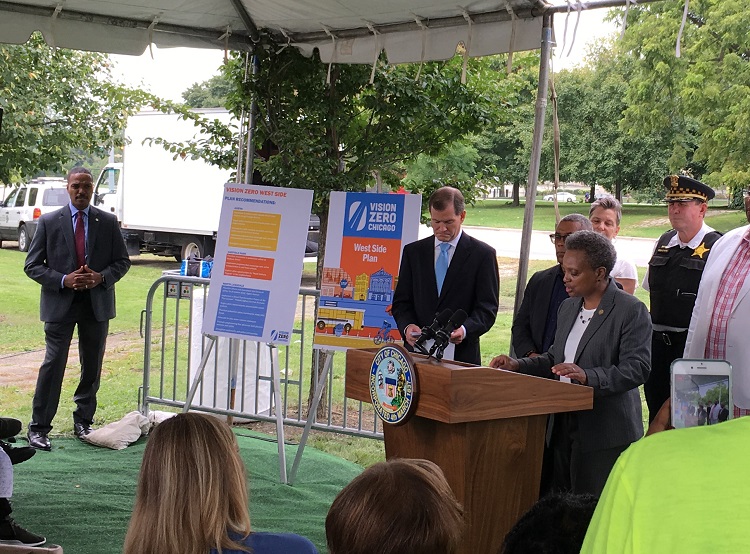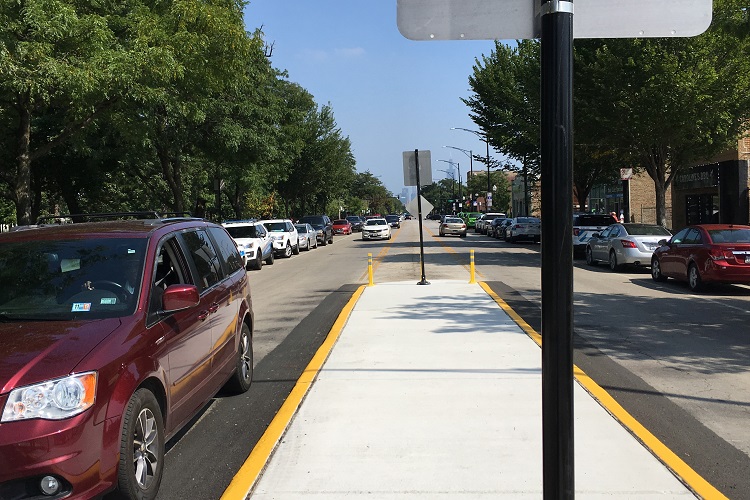Mayor Lightfoot Unveils West Side Vision Zero Traffic Safety Plan
Program Addresses Traffic Safety as a Public Health and Equity Issue, Recommends Infrastructure Projects to Improve Safety in Garfield Park, North Lawndale and Austin
Mayor’s Press Office 312.744.3334
press@cityofchicago.org

Mayor Lori E. Lightfoot today announced the West Side Vision Zero Traffic Safety Plan, the first effort in a push to increase traffic safety on Chicago’s South and West Sides. The Mayor joined Aldermen Howard Brookins Jr. (21st Ward), Walter Burnett Jr. (27th Ward), and Jason Ervin (28th Ward), as well as officials from the Chicago Department of Transportation (CDOT) and other City agencies on the corner of Madison Street at St. Louis Avenue where two new pedestrian refuge islands were recently installed. These islands were created as part of the City’s $6 million investment in safety improvements and programming on the West Side.
“Studies show residents who live in communities that experience economic hardship are three times more likely to die as a result of a traffic crash, which is why our Vision Zero plan and investments are as much about equity as they are about safety," said Mayor Lightfoot. "We must change how we design and use streets, as any traffic-related death is unacceptable when we, as a city, have the tools and strategies to prevent the conditions that lead to these tragedies.”
The Vision Zero West Side Plan includes a total of 15 recommendations on ways to improve traffic and pedestrian safety in East and West Garfield Park, North Lawndale and Austin. The recommendations include targeted safety improvements around transit stations; efforts to encourage safe and active transportation to and from schools; increased investments in infrastructure improvements such as pedestrian refuge islands and sidewalk bump outs and a street transformation project to reconfigure the “Five Corners” intersection of Ogden, Pulaski and Cermak.
“The safety of Chicago’s streets is CDOT’s top priority, and we are pleased that we’ve been able to work with community stakeholders on the West Side to create a Vision Zero plan that reflects the needs of local residents,” said acting CDOT Commissioner Tom Carney. “We look forward to implementing the safety improvements that are outlined in the West Side Plan.”
The West Side plan was crafted with input from residents of communities that have long suffered from disproportionate numbers of traffic crashes and injuries. Its contributors include the Garfield Park Community Council, the North Lawndale Community Coordinating Council, Lawndale Christian Health Center, Build and Austin Coming Together.
“I applaud CDOT and its community partners for their combined efforts to increase safety throughout Chicago and generate recommendations for targeted investments on the West Side to make our streets safer for residents,” said Alderman Ervin.
"Vision Zero is part of the City’s Healthy Chicago 2.0 plan, where safer traffic management contributes to improving overall public health outcomes," said CDPH Acting Commissioner Allison Arwady M.D. "With community members weighing in on traffic safety in their neighborhoods, we’re ensuring our street designs become safer and making it second nature to look out for each other.”

The West Side initiative comes after the initial Vision Zero Chicago Action Plan, released in 2017, used crash data to identify 43 High Crash Corridors and eight High Crash Areas in Chicago, with seven of the eight being on the West and South Side of the City.
“Ensuring pedestrian and traffic safety is one of my top priorities, even more so in areas that face a disproportionate amount of traffic related accidents,” said 27th Ward Alderman Walter Burnett Jr., Chairman of the Committee on Pedestrian and Traffic Safety. “These incidents are preventable, and the West Side plan is the first step in reducing the amount of injuries and fatalities in our neighborhoods.”
The Vision Zero Chicago Action Plan is based on the principles of the international Vision Zero movement to bring together polices, partnerships, and technologies that prevent death and serious injuries from traffic accidents. A similar Vision Zero community engagement process will be implemented on the South Side starting in 2020.
For more information about Vision Zero Chicago and to see the Vision Zero West Side Plan, go to: https://visionzerochicago.org/
